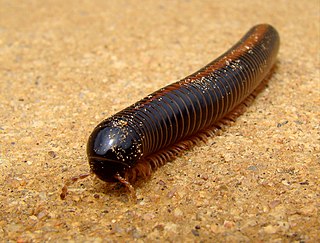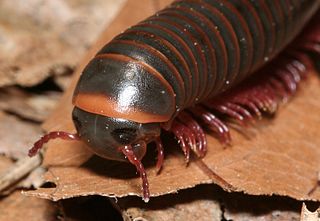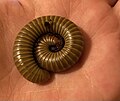
Millipedes are a group of arthropods that are characterised by having two pairs of jointed legs on most body segments; they are known scientifically as the class Diplopoda, the name derived from this feature. Each double-legged segment is a result of two single segments fused together. Most millipedes have very elongated cylindrical or flattened bodies with more than 20 segments, while pill millipedes are shorter and can roll into a tight ball. Although the name "millipede" derives from Latin for "thousand feet", no species was known to have 1,000 or more until the discovery in 2020 of Eumillipes persephone, which can have over 1,300 legs. There are approximately 12,000 named species classified into 16 orders and around 140 families, making Diplopoda the largest class of myriapods, an arthropod group which also includes centipedes and other multi-legged creatures.

The eastern copperhead, also known simply as the copperhead, is a species of venomous snake, a pit viper, endemic to eastern North America; it is a member of the subfamily Crotalinae in the family Viperidae.

Narceus americanus is a large millipede of eastern North America. Common names include American giant millipede, worm millipede, and iron worm. It inhabits the eastern seaboard of North America west to Georgetown, Texas, north of the Ottine wetlands. It has a nearly cylindrical gray body, reaching a length of 4 inches (100 mm). They can be commonly found in or under decaying logs from March to October. When threatened, they sometimes curl up or release a noxious liquid that contains large amounts of benzoquinones which can cause dermatological burns. This fluid may irritate eyes or skin. Many other millipedes secrete hydrogen cyanide, and while there have also been claims that N. americanus releases hydrogen cyanide, they are unsubstantiated. They do, however, excrete a substance that causes a temporary, non-harmful discoloration of the skin known as millipede burn.

Agkistrodon piscivorus is a species of venomous snake, a pit viper in the subfamily Crotalinae of the family Viperidae. It is one of the world's few semiaquatic vipers, and is native to the Southeastern United States. As an adult, it is large and capable of delivering a painful and potentially fatal bite. When threatened, it may respond by coiling its body and displaying its fangs. Individuals may bite when feeling threatened or being handled in any way. It tends to be found in or near water, particularly in slow-moving and shallow lakes, streams, and marshes. It is a capable swimmer, and like several species of snakes, is known to occasionally enter bays and estuaries and swim between barrier islands and the mainland.

Notophthalmus meridionalis, the black-spotted newt or Texas newt, is a species of aquatic newt native to northeastern Mexico and southern Texas in the United States. This amphibian was put on the IUCN Red List of Endangered Species in 2008 with populations still decreasing. It was reclassified to Vulnerable in 2022.

Archispirostreptus gigas, known as the giant African millipede or shongololo, is the largest extant species of millipede, growing up to 33.5 centimetres (13.2 in) in length, 67 millimetres (2.6 in) in circumference. It has approximately 256 legs, although the number of legs changes with each molting so it can vary according to each individual.

Glomerida is an order of pill-millipedes found primarily in the Northern Hemisphere. Also known as northern pill millipedes, they superficially resemble pill-bugs or woodlice, and can enroll into a protective ball. They have twelve body segments, 17 to 19 pairs of legs, and males have enlarged rear legs involved in mating. The order includes about 30 genera and at least 280 species, including Glomeris marginata, the common European pill-millipede. The order contains members in Europe, South-east Asia and the Americas from California to Guatemala. Although historically considered closely related with the similar sphaerotheriidans that also enroll, some DNA evidence suggest they may be more closely related to glomeridesmidans, a poorly known order that does not enroll.

Sanford's brown lemur, or Sanford's lemur, is a species of strepsirrhine primate in the family Lemuridae. Sanford's brown lemur was previously considered a subspecies of the common brown lemur but was raised to full species in 2001. It is named after Leonard Cutler Sanford, a trustee of the American Museum of Natural History.

Motyxia is a genus of cyanide-producing millipedes that are endemic to the southern Sierra Nevada, Tehachapi, and Santa Monica mountain ranges of California. Motyxias are blind and produce the poison cyanide, like all members of the Polydesmida. All species have the ability to glow brightly: some of the few known instances of bioluminescence in millipedes.

Gnamptogenys triangularis is a Neotropical species of ants in the subfamily Ectatomminae. Native to the forests of South and Central America, G. triangularis is a predatory ant that feeds on millipedes. In its native range, this species is known from Buenos Aires, Argentina in the south to Costa Rica in the north, with records from eight countries in South America, and two countries of Central America. The first records of G. triangularis outside its native range came from Florida beginning in 1985 and Alabama in 1996.

Narceus is a genus of large cylindrical millipedes of the family Spirobolidae native to eastern North America. The genus comprises three or four species, two of which are endemic to Florida, and the remainder forming a species complex. The species of Narceus include some of the largest and most recognizable millipedes in eastern North America.

Siphoniulus is a poorly known genus of millipede containing only two living species: S. alba from Indonesia, and S. neotropicus from Mexico and Guatemala. An additional two fossil species are known from Cretaceous amber. Siphoniulus species are the only members of the family Siphoniulidae and order Siphoniulida, making Siphoniulida the smallest millipede order. Few specimens are known, and their classification is contentious, although most recent studies place them as basal members of the Helminthomorpha.

Tylobolus is a genus of millipedes in the order Spirobolida with seven known species found in western North America. It is in the family Spirobolidae, and is the type genus of the subfamily Tylobolinae. The genus was named by Orator F. Cook in 1904.

The greenhouse millipede, also known as the hothouse millipede, short-flange millipede, or garden millipede, is a species of millipede in the family Paradoxosomatidae that has been widely introduced around the world, and is sometimes a pest in greenhouses.
Floridobolus is a genus of millipedes commonly known as Florida scrub millipedes containing three described species: Floridobolus penneri, F. orini, and F. floydi; the latter two described in 2014. All three species are endemic to Florida scrub habitat of peninsular Florida, and F. penneri is considered a critically imperiled species by NatureServe. Prior to the description of F. orini, the genus was considered the sole member of the family Floridobolidae, named by William T. Keeton in 1959, however studies in 2014 have argued that Floridobolus does not represent a distinct family but rather is a basal member of the family Spirobolidae, representing the subfamily Floridobolinae, and tribe Floridobolini.

Titanophyllum spiliarum is a species of cave-dwelling millipede in the family Julidae. The only known species of the genus Titanophyllum, it was described in 2011 from specimens discovered in a cave in Greece. It has several unusual characteristics including eyelessness and a small hook on its hind-most body section that may be involved in keeping the animal ‘locked’ when it coils-up defensively.
Traklosia is a genus of nematodes. The genus was originally circumscribed in 1961 under the name Robertia; L. Travassos and G. R. Kloss created this genus for their newly-described species R. leiperi. The nomen novum, Traklosia, was created for this genus in 2015 — Robertia was an invalid name due to a senior homonym. It consists of three species found in Brazil and Cuba, and they are parasites of millipedes.
Narceus woodruffi is a species of millipede endemic to Florida. Described in 1959, it is the smallest species of the genus Narceus, with adults measuring up to 50 mm in length and 4 mm in width.

Zoosphaerium darthvaderi, also known as the Darth Vader giant pill millipede, is a species of giant pill millipede endemic to the island state of Madagascar. It is named after the Star Wars character Darth Vader. The millipede is restricted to the Ambohitantely Reserve and is considered an extremely endangered species.


















